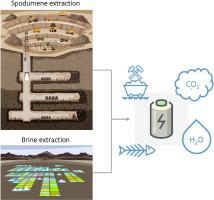Resources, Conservation and Recycling ( IF 13.2 ) Pub Date : 2022-08-31 , DOI: 10.1016/j.resconrec.2022.106634 Mudit Chordia, Sanna Wickerts, Anders Nordelöf, Rickard Arvidsson

|
Life cycle assessment studies of large-scale lithium-ion battery (LIB) production reveal a shift-of-burden to the upstream phase of cell production. Thus, it is important to understand how environmental impacts differ based on the source and grade of extracted metals. As lithium is highly relevant to several current and next-generation cell chemistries, we reviewed the effect of varying grades in different sources of lithium (brine and spodumene) worldwide. The review covered the Ecoinvent database, scientific literature, and technical reports of several upcoming production facilities. The results showed that lower-grade lithium brines have higher environmental impacts compared to higher-grade brines. However, spodumene-based production did not show such a trend, due to different technical process designs of the facilities reviewed. Water use impacts are higher in lower-grade sources and are expected to increase with decreasing lithium concentration. This could specifically be an issue in brine-based production, where brine is extracted from already water scarce regions and evaporated, thus increasing the risk of freshwater availability. However, these aspects of water use are not addressed in existing life cycle impact assessment methods. In the context of large-scale LIB cell production, the reviewed lithium hydroxide production routes account for 5–15% of the climate change impacts.
中文翻译:

当前和未来从盐水和锂辉石供应电池级锂的生命周期环境影响
大规模锂离子电池 (LIB) 生产的生命周期评估研究揭示了电池生产的上游阶段的负担转移。因此,重要的是要了解环境影响如何根据提取金属的来源和等级而有所不同。由于锂与几种当前和下一代电池化学物质高度相关,我们回顾了全球不同锂来源(盐水和锂辉石)中不同等级的影响。审查涵盖了 Ecoinvent 数据库、科学文献和几个即将推出的生产设施的技术报告。结果表明,与高品位的卤水相比,低品位的锂卤水对环境的影响更大。然而,基于锂辉石的生产并没有显示出这样的趋势,因为所审查的设施的技术工艺设计不同。低品位水源的用水影响更大,预计会随着锂浓度的降低而增加。这可能是基于盐水的生产中的一个问题,其中盐水从已经缺水的地区提取并蒸发,从而增加了淡水供应的风险。然而,现有的生命周期影响评估方法并未涉及用水的这些方面。在大规模 LIB 电池生产的背景下,经过审查的氢氧化锂生产路线占气候变化影响的 5-15%。然而,现有的生命周期影响评估方法并未涉及用水的这些方面。在大规模 LIB 电池生产的背景下,经过审查的氢氧化锂生产路线占气候变化影响的 5-15%。然而,现有的生命周期影响评估方法并未涉及用水的这些方面。在大规模 LIB 电池生产的背景下,经过审查的氢氧化锂生产路线占气候变化影响的 5-15%。

























 京公网安备 11010802027423号
京公网安备 11010802027423号